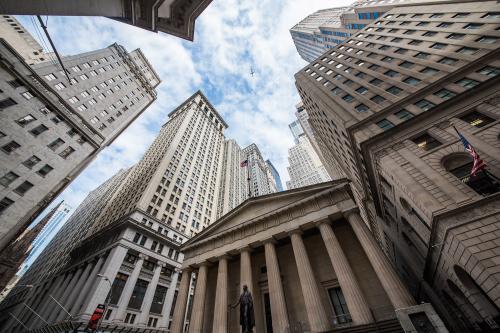I feel privileged to have a chance to interact with this audience, which includes so many people dedicated to the welfare of our region and the people that live here. This is a hard-working, highly motivated group of people struggling with problems that are extremely difficult even in generally prosperous times and are even more daunting in a down economy. I will try to kick off your deliberations by talking about the economic and financial environment which we may all be facing as we go about our jobs in the next couple of years.
Almost a year ago, December 15th, 2008, I spoke to a large group of Washington nonprofit leaders. It was a worried group. The scary events of September 2008 were very recent. Remember the week-end when Lehman and AIG went down, the stock market plummeted, and the Federal Reserve and the Treasury rushed to Capital Hill to talk the Congress into appropriating the huge amount of rescue money they believed—probably correctly—necessary to avoid total meltdown. The economy seemed to be in free fall, the banking and financial system near collapse, people were comparing the situation to the aftermath of the 1929 crash and warning that we might be facing another Great Depression. At the time, U.S unemployment rate was 7.2 percent. The D.C. rate, always a bit higher, was 8.2 percent. Both were expected to rise.
At the time economists, including myself, were somewhat less pessimistic than the media. As I reported, the standard forecast was for continued decline in total spending (GDP) through much of 2009, bottoming out and beginning to increase at the end of 2009 or early 2010. Most economic forecasters thought unemployment would continue to rise to at least 10 percent. Most thought the recovery period would be long and slow, with high unemployment for several years.
A year ago, I said the forecasts of the recession bottoming out before the end of 2009 might be optimistic, but they proved correct. Economic forecasters are not always right, so they need to take credit when they are. Forecasters are especially poor at calling turning points—getting the timing right. But this time they nailed it. The economy is now growing again at a fairly healthy rate. Estimates indicate that total spending grew nearly 4 percent (at an annual rate) in the third quarter of 2009 and is probably growing about that fast now. The consensus of forecasters now is that growth will continue at a pretty moderate pace over the next several years; with unemployment continuing to rise at least into the summer to a peak of high 10 percent or even 11 percent, then declining very slowly over the next several years. If that proves right the jobless pattern will be much like 1982-83 when national unemployment remained above 10 percent for ten months.
However, it is now clear that we are not going to have another Great Depression with 25 percent unemployment. The reasons for that include both the aggressive actions of the government—the stimulus and the rescue of the financial institutions—and the “automatic stabilizers” created in the aftermath of the Great Depression itself and improved in the intervening years.
After the financial crash in 1929, the government dithered and did many of the wrong things—like raising interest rates to try to restore the gold standard. Spending plummeted and there was no safety net to break the fall—no Social Security to maintain the incomes of older people, no Unemployment Insurance to sustain the unemployed. People rushed to banks to withdraw their money, because there was no deposit insurance, and most of the banks failed. This time we had all those safeguards. Moreover, the federal government is a much bigger factor in the economy than it was then, and the automatic decline in federal tax revenue helps maintain incomes.
In addition to the automatic stabilizers, the government acted quickly and aggressively to counteract the recession. The stimulus included aid to those most affected by the recession (increases in food stamps and extensions of unemployment compensation), aid to state and local governments to keep them from having to slash benefits and lay off people, and a variety of infrastructure and other types of projects that will continue to augment total spending over the next year.
The stimulus is temporary—what happens when it is over? Congress will probably extend benefits and aid to state and local governments, though they won’t call it a stimulus. A lot of money from the first stimulus package is as yet unspent, particularly infrastructure money.
Some critics of the stimulus allege that it has not “worked” because unemployment is still rising. Others (sometime the same people) say that the stimulus has propped up spending in the short-run, but the economy will fall back into recession as soon as the effects of the stimulus recede. They can’t have it both ways, however. I believe the stimulus—combined with the success of the Treasury and Federal Reserve in stabilizing the financial system and keeping credit from drying up completely—have made the recession considerably less severe than it would otherwise have been and that the chances are good we will not fall back into recession.
Reaching the bottom of the downward slide is good news, but it does not mean the “recession is over.” Recessions, whether mild or deep, tend to have a similar pattern. The first phase is a cumulative, self-reinforcing decline in total spending. Eventually the slide reaches a “trough” when spending stops falling and begins to increase again—that is where we are now. But businesses continue to lay off workers to cut costs and are reluctant to start hiring again. They increase hours of the employees they have before they hire new employees. So unemployment continues to rise for a while. After the trough spending may bounce back fairly quickly, which will start bring the unemployment rate down soon and quickly—or not. The labor force keeps growing—partly augmented by kids graduating, partly because people who weren’t even looking for work start to look again—so total spending has to be rising pretty fast to reduce unemployment.
This time there are reasons to think that consumer spending—around 70 percent of the total—will be slow coming back. In the run up to this crisis consumers were over-spending, over-borrowing, and spending their rising home equity. Now they have lost both financial wealth and home-equity. Although housing prices are beginning to recover, they will not go back to prior levels anytime soon. Consumers are unlikely to spend at the high pre-crisis rates. They will save more; which is basically a good thing but will slow the recovery.
Reasons for optimism about non-consumer spending include high productivity growth, which is bad for employment but good for profits, and may encourage business investment. The stock market has recovered quite a lot of its value, excess inventories have declined, exports are up (reflecting the good side of the falling dollar), and business spending is beginning to pick up.
Of course, there is always a risk that something will go wrong. The banks are not all stabilized, another wave of foreclosures is possible, especially on commercial property, and an international crisis could develop. But on balance it looks as though we can expect recovery in the national economy to continue, albeit on a slow track.
What about the Washington region? For the region as a whole, we are doing better than most on employment and income; but worse on housing, especially in the areas far from the center. Employment in our region fell much less than it did at the national level (-1.3 percent for the region; -4.1 percent at the national level). We have been adding jobs in government, business services, education and health, while losing some in other sectors. Gross regional product is actually higher than at the end of 2007, and the recent drop is small. On housing we don’t look so good. Prices fell more here than in many regions, because they rose more in the boom. We built too many houses and offices, especially in the outer ring. As a result we have high vacancy and foreclosure rates especially in those high growth areas. We have a high proportion of real estate owned properties (REOs) as a result of over-building and foreclosures.
The recession has exacerbated the huge variations that exist within our region and deepened the historic divide between the growing, prosperous western side of the region and the less prosperous, more distressed eastern side. Within the District, for example, unemployment rates are quite low in Wards 2 and 3, but much higher in Wards 7 and 8. Unemployment in Ward 8 is estimated at over 25 percent—Great Depression levels.
The effect of the recession on non-profits has been very serious, as everyone in the room knows. The story boils down to more problems to solve with fewer resources. The rebound in the stock market is helping some funders, yet most non-profits expect fewer grants this year and next. The next year or two will be a testing time for non-profits’ ability to cooperate in using resources effectively, to accomplish more with less, and to use volunteers (who are showing up in increasing numbers) to best advantage. I can only wish you courage and good luck!
Thank you.



Commentary
The Current Economic Environment: How We Got Here and Where We are Headed
November 16, 2009